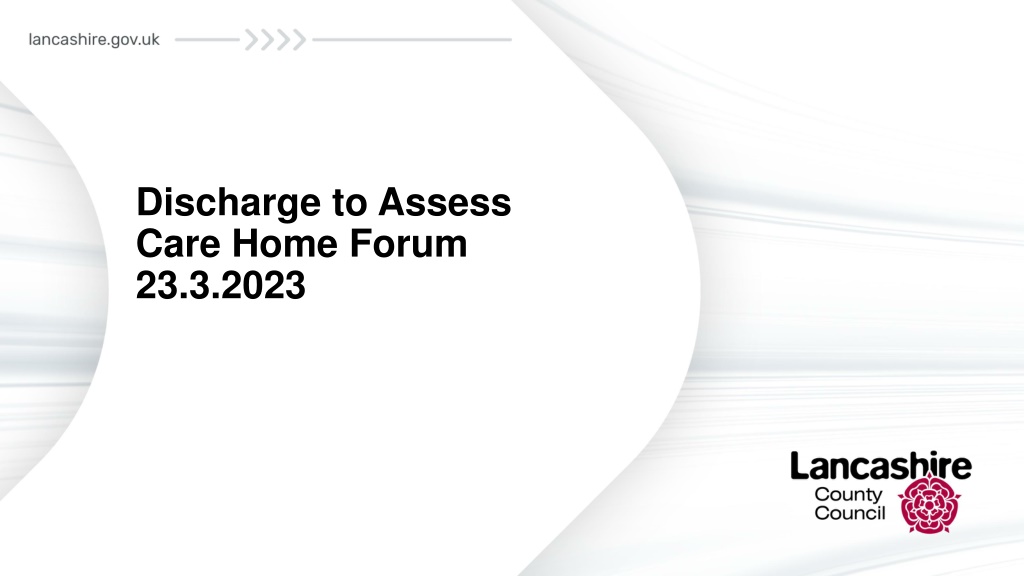Hospital Discharge and Assessment Processes Overview
Overview of hospital discharge and assessment processes including Discharge to Assess guidelines, Not Meeting Criteria to Reside (NMC2R) protocols, and Bed Based Discharge procedures. Details on timelines, legislation changes, and challenges in ensuring accurate discharges are discussed.
Download Presentation

Please find below an Image/Link to download the presentation.
The content on the website is provided AS IS for your information and personal use only. It may not be sold, licensed, or shared on other websites without obtaining consent from the author. Download presentation by click this link. If you encounter any issues during the download, it is possible that the publisher has removed the file from their server.
E N D
Presentation Transcript
Discharge to Assess Care Home Forum 23.3.2023
Hospital Discharge/Discharge to Assess Care Act 2014 Delayed Transfers of Care. Complicated counting system but broadly ASC had a minimum of 3 days and a maximum of 5 days to assess, put services in place and achieve the discharge 19thMarch 2020 Under national covid legislation, the Hospital Discharge & Operating Model was published. Mandated a discharge to assess (D2A) process, giving 2-4 hours to put services in place and facilitate discharge. October 2020 Policy was refreshed. D2A still mandated. Timescales: aim for 2-4 hours, but certainly within the same day July 2021 Policy further refreshed to become the Hospital Discharge and Community Support: Operating Model. Discharges should happen within the same day, ideally within 2 hours. All discharges must be safe. 1 Jul 2022 Section 91 of the Health and Care Act came into force on 1 July 2022. It revoked procedural DToC requirements in Schedule 3 to the Care Act 2014. D2A is the preferred model but not mandated. Discharge should happen within the same day, ideally within 2 hours. All discharges must be safe.
Not Meeting Criteria to Reside (NMC2R) All people who no longer meet the clinical criteria to reside for inpatient care in acute hospitals should be discharged as soon as possible, ideally within a few hours, mostly the same day NMC2R delays anyone identified as NMC2R and still in hospital at 11am the next day. National target no more than 5% of total people occupying the hospital NMC2R LSC Picture 22ndMarch 2023 Number of Occupied General & Acute ADULTBeds (LSCFT number of Adult / PICU Patients) Total Number of Patients Not Meeting Criteria To Reside Minus Discharge date Total Number of Patients Not Meeting Criteria To Reside % NMC2R Minus discharge date of ADULT GA BEDS 7 Day LOS % of ADULT GA Beds % Total NMC2R of ADULT GA Beds Blackpool 123 112 751 16.4% 14.9% 55.0% East Lancs 49 43 664 7.4% 6.5% 49.4% Lancs Teaching 58 41 819 7.1% 5.0% 53.5% Univ Hospital Morecambe Bay 110 99 572 19.2% 17.3% 51.4% LSCFT 80 18 404 19.8% 4.5% HLSC Total 420 313 3,210 13.1% 9.8% 52.5%
Bed Based Discharge To Assess The Process The Hospital does an assessment of need, and completes a nursing needs assessment if this level of support is indicated Depending on the hospital, the social care team may scrutinise and participate in the decision making Depending on the hospital, the sourcing of the placement is undertaken by LCC, the CSU (NHS Commissioning Support Unit) or the Hospital themselves Placement secured, person and where appropriate family/carer confirms agreement Admission date agreed Hospital arranges discharge Person followed up by LCC and/or NHS
Challenges Accuracy of hospital s assessment Accuracy of information about the person s needs Choice is limited under D2A due to required speed of discharge, and severely limited when the Hospital is formally at OPEL 4 Speed of discharge required What happens if the discharge is poor/unsafe Communication about the discharge Timeliness of follow-up Short term nature of the D2A placement Time taken to settle in/register with a GP/draw up care plan etc
Challenges cont. Wide range of fee rates Lack of contract with the Care Home and with the person/family Fee rates at the end of the D2A period Potential multiple moves for the person Lack of therapy input DOLS Where the person s needs change or exceed the registration of the current placement
Bed Based D2A Specification Working up a consistent Bed Based D2A Spec Sets out the service to be commissioned Expectations of the Care Provider Expectations of the NHS Expectations of the Social Care Team Consistent fee rate for services provided Grace period if the person is readmitted to hospital NHS and Social Care to operate to the same specification
Challenges provider perspective Please tell us what the issues are from your perspective

























